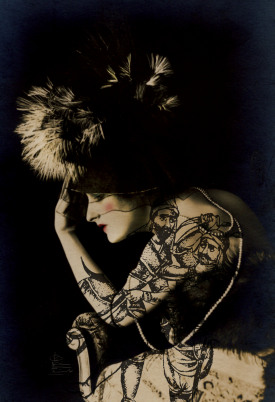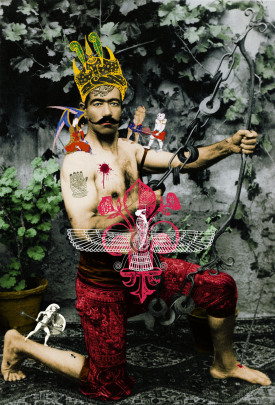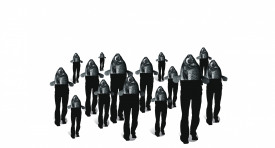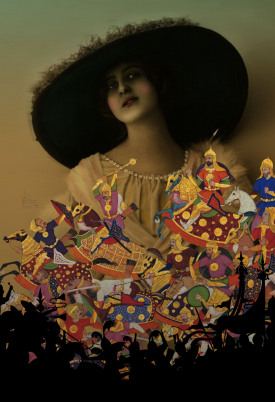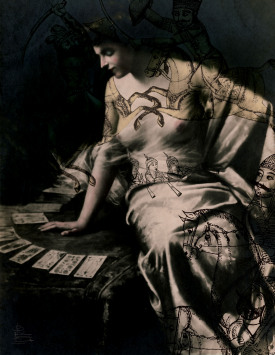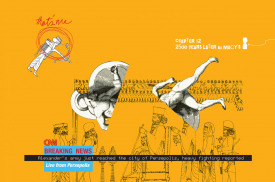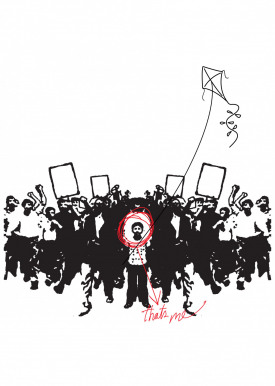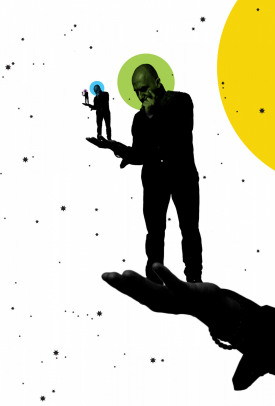Hamid Rahmanian
by Mark Sloan
Born in Tehran in 1968, multimedia artist Hamid Rahmanian is now based in New York. His sense of “home” was powerfully shaped by his childhood in Iran and by the rich histories of the Persian Empire.
On one of my first encounters with the artist at his home in Brooklyn, New York, he prepared a Persian breakfast for me in his kitchen. As he was cracking quail eggs, adding a pinch of sumac, and I was sipping a fragrant tea, he was describing how food—in particular the spices—had played a pivotal role in his upbringing. He then took me into his studio and showed me a dazzling self-portrait/graphic novel called Multiverse: To Myself with Love, as well as the early stages of his work on the Iranian epic poem Shahnameh.
Hamid’s Multiverse work was selected for exhibition at the Halsey Institute because it was a poetic and imaginative interpretation of what it was like for Hamid as a new immigrant to the United States, complete with confusing customs, nonsensical linguistic constructions, and the mysteries of assimilation as his subject matter. He and I worked together to translate his graphic novel into an exhibition—not an easy task. We chose to explode the book apart into its constituent elements and to vary the scale of each on the walls of the gallery. Some elements became enormous wall tattoos; others were printed as stickers placed on top. The layering of imagery was analogous to the layered experiences Hamid encountered as a newcomer to the United States juxtaposed with recollections of his childhood in Tehran. There were areas of overlap, of course, whereas other areas remained completely opaque, overwhelming, and unresolved (perhaps to this day). The gallery became like a multifaceted jewel box, filled with myth and memories. It represented the artist’s attempt to reconcile his conceptions of home with his dream of a new land of opportunity and adventure.
Hamid also explored the concept of “home” through an extraordinary encounter he related in his documentary Sir Alfred of Charles De Gaulle Airport (2001), which chronicles the experiences of an Iranian refugee who lived in the departure lounge of Terminal One in the Parisian airport from 1988 to 2006 because he did not have the proper paperwork to enter France. (Hamid’s documentary became the basis for the Steven Spielberg film The Terminal, starring Tom Hanks.) By profiling this Iranian man who was literally “homeless,” Hamid was further exploring his own sense of isolation, exclusion, and displacement.
Persian cultural history, particularly as described by Ferdowsi in the tenth-century epic poem entitled Shahnameh: The Epic of the Persian Kings, became a focal point for this multimedia artist’s creative energies beginning in 2013. Rahmanian commissioned an English translation of the poem and illustrated it profusely using a digital-collage technique that he invented. This project became a best-selling six-hundred-page book published by Quantuck Lane Press (a division of W. W. Norton & Company) and has since been spun off into pop-up books and several award-winning shadow-puppet theater productions. Among the latter is Feathers of Fire, which has circled the globe, with performances at The Metropolitan Museum of Art in New York and many other world-class venues. The Shahnameh project is an extension of Hamid’s fascination with his native land and his ongoing efforts to counter stereotypes of Iranian citizens. Although living in America now, Hamid retains his love of his Persian roots, and he uses every opportunity to share its riches with new audiences. In this sense, the locus of his work forms a hinge point for greater understanding between East and West.
Hamid Rahmanian
Born in Tehran, Iran (1968)
Lives and works in New York, New York
Hamid Rahmanian was raised and educated in Tehran, Iran. Rahmanian earned a BFA from Tehran University in 1990 and went on to work in Tehran for many years as a celebrated graphic designer. Rahmanian immigrated to the United States and earned an MFA in Computer Animation from Pratt Institute, New York in 1997. He established his own production company, Fictionville Studio, in 1998. Rahmanian’s work intertwines reality and fantasy to reflect on what it means to be an immigrant in a global narrative that defies borders.
Rahmanian’s narrative and documentary films have premiered at Venice, Sundance, Toronto, Tribeca, and IDFA film festivals. He has won numerous international awards and his films have been televised on international networks, including PBS, Sundance Channel, IFC, Channel 4, BBC, DR2, and Al Jazeera. Rahmanian’s films have gained international recognition for their socially conscious storylines. In addition to his films, Rahmanian has created multiple books including undertaking the immense task of illustrating and commissioning a new translation and adaptation of the tenth-century Persian epic poem the Shahnameh by Ferdowsi, entitled Shahnameh: The Epic of the Persian Kings (2017).
He received a United States Artist Fellowship in 2020 and a Film Fellowship from the John Simon Guggenheim Memorial Foundation in 2014.
Hamid Rahmanian’s work was featured at the Halsey Institute in 2011 in Multiverse.
Mark Sloan
Mark Sloan has been the Director and Chief Curator of the Halsey Institute of Contemporary Art at the College of Charleston School of the Arts since 1994. In his 26-year career at the Halsey Institute, Sloan has organized 244 exhibitions featuring the work of 343 artists. Several of his exhibitions have traveled to institutions such as the High Museum in Atlanta, Yerba Buena Center for the Arts in San Francisco, the New Orleans Museum of Art, and Presentation House in Vancouver. He has authored or co-authored sixteen books on subjects ranging from Russian conceptual art to visionary artist’s environments to photographs from the archive of cartoonist Robert Ripley. He is also an active photographic artist whose works have been exhibited internationally, including at the High Museum in Atlanta, the Grand Palais in Paris, the American Academy of Sciences in Washington, D.C., and the Harvard Museum of Natural History in Cambridge. Sloan earned his MFA in Photography from Virginia Commonwealth University.


